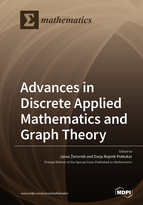Advances in Discrete Applied Mathematics and Graph Theory
A special issue of Mathematics (ISSN 2227-7390). This special issue belongs to the section "Mathematics and Computer Science".
Deadline for manuscript submissions: closed (31 December 2021) | Viewed by 24315
Special Issue Editors
2. Institute of Mathematics, Physics, and Mechanics, 1000 Ljubljana, Slovenia
Interests: graph theory; discrete optimization; algorithms; heuristics and metaheuristics
Special Issues, Collections and Topics in MDPI journals
Interests: graph theory; topological indices; stochastic processes
Special Issues, Collections and Topics in MDPI journals
Special Issue Information
Dear Colleagues,
Since its origins in the 18th century, graph theory has been a branch o mathematics that is both motivated by and applied to real world problems. Research in discrete mathematics increased in the latter half of the twentieth century mainly due to development of digital computers. On the other side, the advances in technology of digital computers enables extensive application of new ideas from discrete mathematics to real-world problems.
This special issue intends to promote novel examples of application of graph theory and discrete mathematics, as well as purely theoretical works with foreseen impact to applications. The editors do not intend to narrow the scope of applications, and also encourage studies in standard areas of application that may be of particular interest recently, such as discrete models in epidemiology or advanced graph theoretical models used in drug design, both in view of the current pandemy.
- Discrete Optimization
- Graph Algorithms
- Graph Theory
- Applied Mathematics and Modeling
- Operations Research
Prof. Dr. Janez Žerovnik
Dr. Darja Rupnik Poklukar
Guest Editors
Manuscript Submission Information
Manuscripts should be submitted online at www.mdpi.com by registering and logging in to this website. Once you are registered, click here to go to the submission form. Manuscripts can be submitted until the deadline. All submissions that pass pre-check are peer-reviewed. Accepted papers will be published continuously in the journal (as soon as accepted) and will be listed together on the special issue website. Research articles, review articles as well as short communications are invited. For planned papers, a title and short abstract (about 100 words) can be sent to the Editorial Office for announcement on this website.
Submitted manuscripts should not have been published previously, nor be under consideration for publication elsewhere (except conference proceedings papers). All manuscripts are thoroughly refereed through a single-blind peer-review process. A guide for authors and other relevant information for submission of manuscripts is available on the Instructions for Authors page. Mathematics is an international peer-reviewed open access semimonthly journal published by MDPI.
Please visit the Instructions for Authors page before submitting a manuscript. The Article Processing Charge (APC) for publication in this open access journal is 2600 CHF (Swiss Francs). Submitted papers should be well formatted and use good English. Authors may use MDPI's English editing service prior to publication or during author revisions.
Keywords
- Discrete Optimization
- Graph Algorithms
- Graph Theory
- Applied Mathematics and Modeling
- Operations Research







